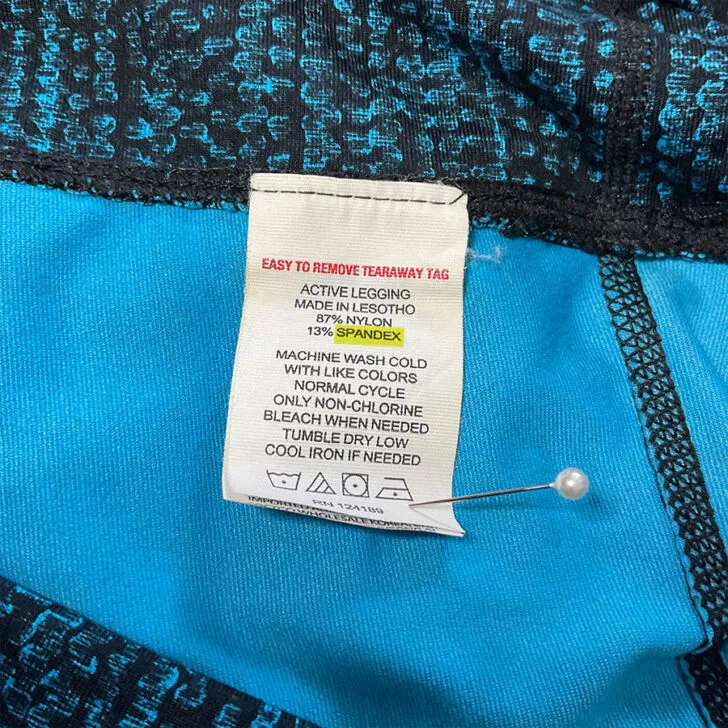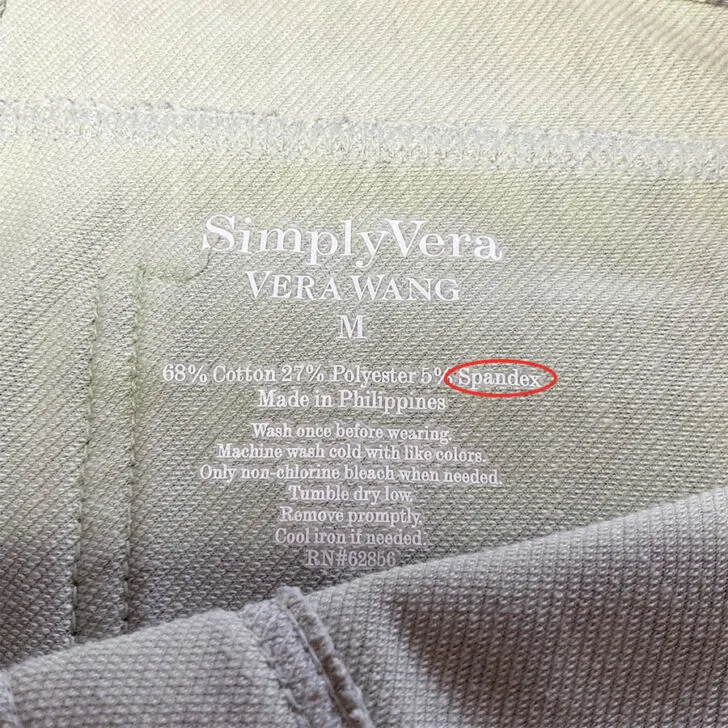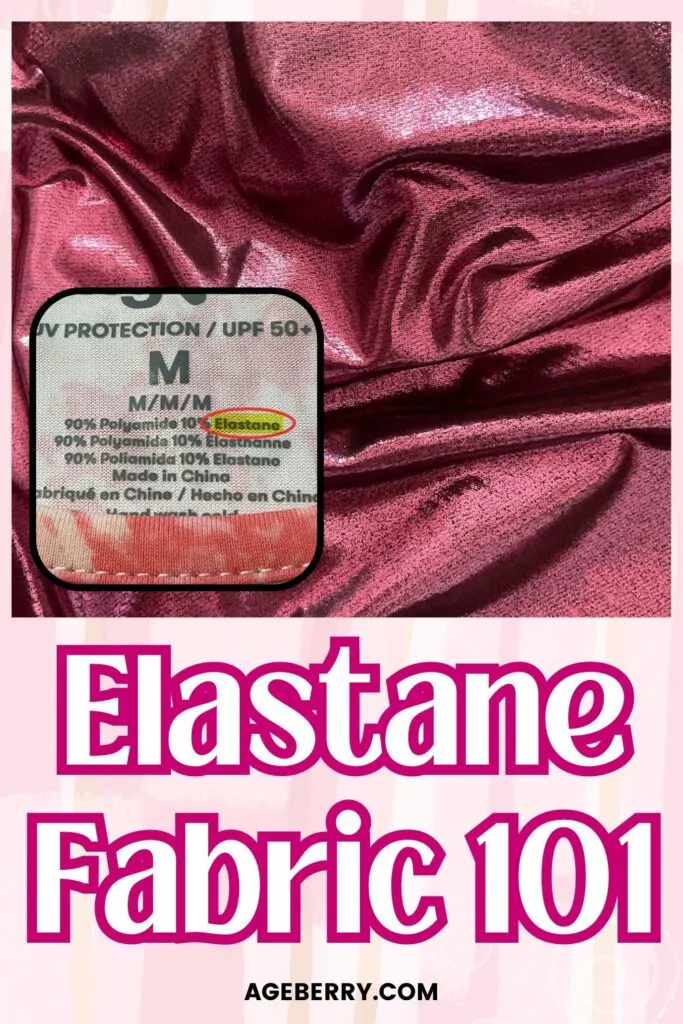If you’ve ever worn clothing that had some stretch, chances are good that you’ve worn something with elastane in it (ex: socks!). But what is elastane fabric and how is it different from other well-known stretchy materials such as spandex or Lycra?
Elastane fabric (also often called Spandex or Lycra) is a synthetic material known for its impressive elasticity and stretchability. Invented in 1958 by chemist Joseph Shivers at the DuPont company (https://en.wikipedia.org/wiki/Spandex ), it has revolutionized clothing, sportswear, and compression garments.

Producing elastane fabric involves creating long-chain polymers from polyurethane. Then, manufacturers blend these polymers with other fibers, such as cotton or polyester, to make fabrics with the clothing manufacturer’s desired level of stretch and comfort.
Elastane fabric can stretch up to 500% of its original size! With stretch like that, it’s a material that feels great to wear, meaning consumers love it and want more of it. As a result, it has become a popular choice for designers and manufacturers.
However, life isn’t entirely rosy in the world of elastane because even though the material offers unparalleled stretch, comfort, and versatility, many people have concerns about its environmental impact.
So, let’s take a closer look at the advantages and drawbacks of elastane fabric.
What is Elastane fabric?
Elastane fabric is a popular petroleum-based, synthetic fabric that’s famous for its stretchy comfortable fit and feel when used in clothing. It’s frequently used in daily clothing items, athletic wear, and swimwear.
As someone who has worked with various types of fabrics, I especially like woven fabrics with elastane. Not only knit fabrics can be stretchy. Elastane fibers have revolutionized the textile industry by introducing stretch to woven fabrics as well. Now, for example, we have the luxury of stretchy jeans, which is a testament to the versatility of elastane.
I remember the first time I bought a stretchy cotton fabric with 5% spandex. The addition of elastane to the cotton made the fabric more forgiving and flexible, which was perfect for my project. I was so happy because I could create a very close-fitting dress that was not only comfortable but also flattering to the body’s contours.
The fabric could “hug” the figure without constriction, allowing for a range of movement that pure woven fabrics couldn’t offer. And since then, I used cotton/elastane fabric very often. In fact, as I write this article, I have one such fabric on my sewing table right now.

But it’s not just about the added comfort; it’s also about the ability to maintain the shape of the garment. The resilience of elastane means that my creations retain their form even after multiple wears and washes.
Elastane vs. Spandex vs. Lycra
Other well-known terms, like Spandex and Lycra, are often used interchangeably with Elastane. Although they all refer to the same material, the usage of different terms tends to vary depending on the region.
The name Lycra is a brand name of elastane. On the other hand, the term “elastane” is a generic term commonly used worldwide, while “spandex” is a generic term that’s mostly used in North America.
Fun Fact: “Spandex” is an anagram of “expands,” which is the most notable quality of the material!

Origin And History Of Elastane
Otto Bayer developed one of the primary components (polyurethane) in Germany in 1937 as a replacement for rubber. At that time, rubber (the most common elastic material at the time), was in high demand to produce many different types of equipment, so it was subject to problematic price fluctuations (https://en.wikipedia.org/wiki/Spandex ).
Then, in the late 1950s, an American chemist named Joseph Shiver, who worked for DuPont Corporation, took polyurethane and used it to pioneer the invention of a fiber that showed unprecedented abilities to stretch and recover. DuPont holds the trademark for elastane and branded it with the name Lycra.
Properties Of Elastane
As a synthetic fiber, elastane is completely artificial and does not occur naturally anywhere in the world. Instead, it’s produced through a series of chemical reactions.
Chemical Properties
Unlike natural fibers such as wool or cotton, elastane isn’t found in nature. Humans take long polyurethane chains (derived from petroleum) and form them into a fiber that’s lightweight but very strong and extremely stretchy.
Here are a few other qualities that this material can thank its polyurethane polymer chemistry for:
- Resists deterioration when it comes in contact with body oils, sweat, lotions, or detergents.
- Resists scratches and abrasions.
- Stronger and more durable than rubber.
Physical Properties
Elastane stands apart from other fabrics thanks to its unparalleled stretchability, making it a vital component in many of today’s clothing items.
Elastane fabric continues to gain popularity as an in-demand material thanks to certain properties. It’s:
- Lightweight.
- Smooth, soft, and comfortable against the skin.
- Wrinkle-resistant.
- Beneficial to help clothing keep its shape (prevents bagging or sagging).
- Easy to dye.
- Able to repeatedly stretch and go back to its original shape.
- Resistant to wear and tear.
Disadvantages Of Elastane Fabric
While there are many pros with elastane, there are also a few disadvantages:
- Cannot be used alone in items that people wear; it needs to be combined with other fibers for use in clothing.
- Fibers can be broken down by chlorine.
- Easily damaged by heat.
- As a synthetic material, it’s not breathable.
- Can lose its stretch with repeated use.
- Is an environmental concern because it’s not biodegradable.
- Tricky to sew because the stitch needs to be able to stretch with the fabric. (If you plan to sew stretching fabric, learn more about using stretch stitches on your machine.)
Uses Of Elastane
This fabric is an innovation whose versatility has made it an essential material in many industries, including textiles, sports, and medicine.
Elastane Clothing Applications
Its many beneficial qualities make it an ideal material to use in sportswear, yoga pants, jackets, jeans, and other garments where flexibility and durability are essential.
Here are some of the most common uses for elastane in the clothing and textile industry.
Sportswear and Athletic Wear
Elastane fibers can be knitted or woven, depending on the intended use of the final fabric. No matter how it’s put to use in clothing, it’s always blended with at least one other material (ex: cotton or polyester).

In the past few decades, athletes and designers have rapidly discovered and fallen in love with its lightweight feel and easy-to-move stretchability.
It’s an ideal material for (and now often found in) clothing items such as leggings, shorts, yoga pants, and sports bras as its elasticity offers athletes and other active people freedom of movement and maximum comfort while also providing contour-fitting support.

Underwear and Intimate Apparel
You will frequently find elastane fabric in underwear and intimate apparel thanks to its soft and smooth texture. Socks and bras now typically contain spandex, too, because its ability to stretch and go back to its original shape provides comfort against the skin.
Note: Some of the links on this page are affiliate links. This means I will receive a commission if you order a product through one of my links. I only recommend products I believe in and use myself.

Dickies Dri-tech Moisture Control Crew Socks
Everyday and Form-Fitting Garments
Form-fitting garments require a certain amount of elastane in the material to help them retain (or go back to) their shape. Some examples of clothing items that include spandex are tops and form-fitting dresses.
Elastane Uses In The Medical Field
The clothing industry isn’t the only place you’ll find elastane used – it’s common in the field of medicine as well! Here are a few common ways you’ll see spandex employed in the medical field.
Compression Bandages And Garments
One key application of elastane in the medical field involves producing compression bandages. These are frequently used items because they apply consistent pressure to an injured area, promoting blood circulation, reducing swelling, and enabling faster healing.

Beister Lymphedema Medical Compression Arm Sleeve with Gauntlet
In addition, companies that manufacture compression stockings for people recovering from surgeries or those who have circulatory disorders use elastane. Compression stockings help improve blood flow and prevent blood pooling in the legs or arms to encourage healing. Elastane helps create the ideal snug fit to ensure the stockings provide the right amount of pressure while still being comfortable to wear.
Believe it or not, you can find elastane in compression garments for scar management, which helps reduce the appearance of scars by applying constant pressure on the affected area, promoting healthy collagen formation during the healing process.
Orthopedic Supports
Another important application of elastane is in orthopedic supports, such as braces and splints. These products provide support and stabilization to injured joints while they heal. Elastane’s ability to conform to the body shape and maintain its elasticity allows for a secure fit that won’t compromise mobility during recovery.
Shapewear
Finally, elastane is a major component of shapewear for patients who have undergone procedures such as liposuction or abdominal surgeries to help them maintain their new body shape as they heal.
Elastane Uses In The Sports Industry
Given how useful elastane is in the clothing and medical industries, you can probably see how this one-of-a-kind fiber can use its benefits to contribute to the sports industry.
Its lightweight feel, softness, comfortability, and freedom of movement allow athletes to perform at their highest levels, making it a key component in athletic wear.
Additionally, elastane is very durable and resistant to deterioration when it comes into contact with substances, such as body oils, sweat, lotions, and detergents. This is especially beneficial for compression bandages and garments that need to maintain their strength in order to provide benefits.
Some common uses for elastane fabric in sports include:
- Swimwear
- Tights and leggings
- Compression wear
- Cycling shorts
- Yoga pants
- Sports bras
Elastane Fabric Blends
While elastane fabric is clearly in demand and versatile, it’s never used alone – it is always combined with other fabrics. Most elastane blends contain 5 to 10% elastane (or spandex) to create the desired amount of stretch in garments.
Cotton-elastane blends and polyester-elastane blends are the most frequently used because they provide a good fit and are easy to wear. At times you’ll see nylon in the mix as well. Blended fabrics, such as cotton-elastane and polyester-elastane, combine the advantages of each type of fiber.
Here’s a quick rundown of the various common fabric-elastane blends you’ll run into:
Cotton-Elastane Blend
The softness and breathability of cotton meld with the stretchiness and wrinkle resistance of the elastane to create comfortable casual clothing and garments.
Common cotton-elastane items include t-shirts, leggings, jeans, and underwear.

Polyester-Elastane Blend
The durability and quick-drying properties of polyester (another synthetic material) combine with the elastane’s stretching properties to create incredible high-performance wear.
Common polyester-elastane items include sportswear, swimwear, and other activewear apparel.
Learn more about cotton-polyester blends and how adding spandex to them changes their properties.

Wool-Elastane Blend
In addition to cotton and polyester, elastane also blends well with other fibers such as wool and nylon. Wool, being a natural insulator, is an excellent choice for temperature regulation in garments.
As a result, this mix creates a form-fitting, stretchy fabric that can maintain warmth.
Common wool-elastane blend items include winter clothing such as thermal underwear, socks, and outdoor jackets.
Nylon-Elastane Blend
Mixed with nylon, another synthetic fiber, known for its strength and scratch resistance, this blend offers excellent durability and flexibility.
Common nylon-elastane blend items include sportswear, hosiery, and intimate apparel.

Poly Viscose Elastane Fabric
Finally, you will sometimes see elastane blended with viscose (also called Rayon) and polyester. This combination provides an excellent drape with wrinkle resistance and a wool-like finish.
Common poly viscose elastane blend items include blouses, skirts, and drapey dresses.
Care And Maintenance of Elastane Fabrics
Elastane has many benefits, but it’s important to know that in terms of maintenance, it doesn’t tolerate heat well.
In order to keep your garments with elastane looking and feeling their best, follow these recommended care guidelines:
- Wash with cold water.
- Use a regular or mild detergent.
- Use a gentle cycle.
- Do not use chlorine bleach.
- Air dry when possible or dry on a low heat setting.
- Store away from sunlight (learn more about how to store fabric here).
- Do not iron.
Does Elastane Shrink?
I vividly recall an incident from my early days of working with cotton/spandex fabric. At the time, I was not as familiar with the heat sensitivity of spandex. I decided to iron the fabric and, without thinking, I set the iron to the temperature appropriate for cotton. It was a big mistake. The fabric shrunk right in front of my eyes, warping from the high heat. That moment was a lesson learned the hard way. From that point on, I’ve never used such a high temperature again when working with elastane blends.
So, elastane is sensitive to high temperatures, which means that elastane can shrink or lose elasticity if exposed to heat during washing, drying or ironing.
When elastane is blended with cotton, the propensity to shrink can increase because cotton is a natural fiber that tends to shrink more easily. And when elastane is blended with polyester, it may not shrink at all if you wash it in cold water and iron on low heat.
To minimize shrinkage and maintain the life of elastane-containing garments, follow proper care instructions, which include washing in cool water and air-drying or using a low-temperature setting on a dryer and iron.
Environmental Considerations Of Elastane
Since elastane is a synthetically engineered material, it’s important to consider the environmental impacts that this fabric has.
Traditional elastane fabric is non-biodegradable, so it could take up to 200 years to break down completely. This significantly contrasts with natural fibers like wool or cotton, which are fully biodegradable.
Although recycling options for elastane are limited, there is an ongoing effort to develop more sustainable versions of the fabric. For example, the LYCRA company released Lycra T400 EcoMade fiber in 2014, which was the first bio-based elastane product. It provides stretch through the use of recycled and plant-based materials
In addition, while this material is considered safe to use once manufactured, it has a rather large production footprint due to the chemicals and energy required for processing petroleum to create elastane.
Further, when you wash garments made from synthetic materials, such as elastane, tiny particles (called microplastics) can be released into the water. Eventually, these microplastics can end up in oceans and can harm marine life.
To help prevent releasing microplastics into various water supplies, you can wash your elastane clothing in laundry bags that collect microplastics.
Finally, because elastane isn’t biodegradable, it contributes to the landfill waste problem. There are ways to recycle natural fibers such as cotton and wool, but there currently isn’t a way to recycle elastane.
Where to Buy Fabrics with Elastane/Spandex
I love to use elastane-based fabrics for various projects. Whenever I visit New York, I make sure to stop by Spandex House, a store I’ve come to rely on for all my spandex needs.
The store is located in the heart of New York City’s Fashion District, and they have a huge selection of spandex fabrics in different textures, colors and patterns. I can usually find exactly what I need there. Spandex House is a go-to destination for anyone in need of spandex fabrics for apparel, dancewear, swimwear, or other custom creations.
But they also sell fabric online. Go to this link (I am not affiliated with them).
Frequently Asked Questions
Is Elastane Good For Sensitive Skin compared to Natural Fabrics Like Cotton?
Elastane is a synthetic material that may cause irritation for individuals with sensitive skin. However, when it is blended with natural fibers like cotton in clothing, the risk of skin irritation goes down based on the percentage of elastane fabric in the blend.
If you have sensitive skin, try to stick with clothing that’s made only with natural fibers (ex: 100% cotton) or has a higher percentage of natural fibers (like 95%) and a lower elastane content (like 5%).
Is Pure Elastane or an Elastane Blend More Comfortable to Wear?
While pure elastane is highly elastic, it’s not breathable or moisture-wicking. That’s why clothing manufacturers like to blend it with other fabrics to enjoy the benefits that both materials offer. As a general rule of thumb, blended fabrics usually provide a more balanced combination of comfort and performance.
I hope this post answered all your questions about spandex! With its resistance to wrinkles and wear and tear combined with its unparalleled stretchy versatility, it’s no wonder why elastane fabric has become so popular in clothing and multiple industries.
Was this guide on elastane fabric useful to you? Don’t forget to save this pin (see below) to your sewing board on Pinterest so you can revisit this article whenever you need it. For more sewing advice, how-to guides, and creative inspiration, make sure to follow me on Pinterest!

latest posts
- Knot a Problem: Easy Ways to Secure Short Thread Ends
- Ever Tried This on Your Serger? This Differential Feed Feature Will Amaze You
- Ditch My Sewing Machine? Not in This Lifetime!
- Adorable DIY Needle Book | Easy Tutorial for Beginners
- Master the Seam Ripper: Your Ultimate Guide to Precision Stitch Removal
- Think You Know Zippers? This Installation Guide Might Surprise You
- Why Does Your Seam Ripper Have a Red Ball? Discover Its Purpose!
- Topstitching Troubles? This Simple Trick Will Turn It Around Instantly!
- How to Sew Shirring: A Step-by-Step Guide to Elastic Thread Gathering


